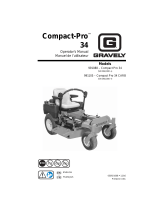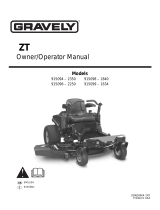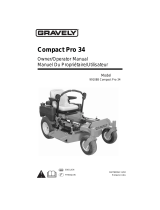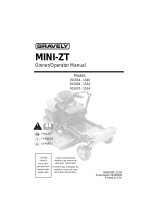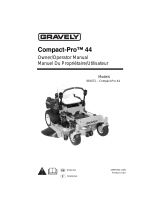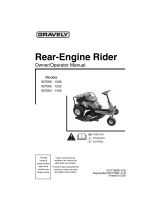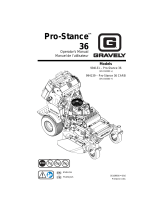Page is loading ...

E10
Owner/Operator Manual
Manuel Du Propriétaire/Utilisateur
Models
991200 – Pro-Turn 48
(SN 020000 +)
991201 – Pro-Turn 52
(SN 020000 +)
991202 – Pro-Turn 60
(SN 020000 +)
991203 – Pro-Turn 60
(SN 020000 +)
991204 – Pro-Turn 48 CARB
(SN 020000 +)
991205 – Pro-Turn 52 CARB
(SN 020000 +)
991206 – Pro-Turn 60 CARB
(SN 020000 +)
Pro-Turn
04519000A 10/12
Printed in USA
ENGLISH
FRANÇAIS
The use of any gasoline exceeding 10% ethanol (E10) or
10% MTBE will void the product warranty.
L’utilisation d’une essence contenant plus de 10% d’éthanol
(E10) ou de 10% de MTBE annulent la garantie.
™

EN - 2
Safety . . . . . . . . . . . . . . . . . . . . . . . . . . . 5
Assembly . . . . . . . . . . . . . . . . . . . . . . . 14
Controls and Features. . . . . . . . . . . . . 16
Operation . . . . . . . . . . . . . . . . . . . . . . . 17
Maintenance Schedule . . . . . . . . . . . . 23
Service and Adjustments . . . . . . . . . . 25
Storage . . . . . . . . . . . . . . . . . . . . . . . . . 37
Accessories . . . . . . . . . . . . . . . . . . . . . 38
Service Parts . . . . . . . . . . . . . . . . . . . . 38
Specifications . . . . . . . . . . . . . . . . . . . 39
Warranty . . . . . . . . . . . . . . . . . . . . . . . . 41
NON-ENGLISH MANUALS
Manuals in languages other than
English may be obtained from your
Dealer. Visit your dealer or
www.ariens.com for a list of
languages available for your
equipment.
Manuals printed in languages
other than English are also
available as a free download on
our website:
http://www.gravely.com
MANUALES EN IDIOMAS
DIFERENTES DEL INGLES
Puede obtener manuales en
idiomas diferentes del inglés en su
distribuidor. Visite a su distribuidor
o vaya a www.ariens.com para
obtener una lista de idiomas
disponibles para su equipo.
También puede imprimir manuales
en idiomas diferentes del inglés
descargándolos gratuitamente de
nuestra página Web:
http://www.gravely.com
Manuels non anglais
Des manuels dans différentes
langues sont disponibles chez
votre revendeur. Rendez-vous
chez votre revendeur ou allez sur
le site www.ariens.com pour
consulter la liste des langues
disponibles pour votre
équipement.
Les manuels imprimés dans des
langues différentes de l’anglais
sont également disponibles en
téléchargement gratuit sur notre
site Web :
http://www.gravely.com
THE MANUAL
Before operation of unit, carefully and
completely read your manuals. The contents
will provide you with an understanding of
safety instructions and controls during normal
operation and maintenance.
All reference to left, right, front, or rear are
given from operator sitting in the operation
position and facing the direction of forward
travel.
ENGINE MANUAL
The engine on this unit is covered by a
separate manual specific to the engine. This
manual is included in the literature package
that shipped with the unit. Refer to this
manual for engine service recommendations.
If the engine manual is not available, contact
the engine manufacturer for a replacement
manual.
SERVICE AND REPLACEMENT
PARTS
When ordering publications, replacement
parts, or making service inquiries, know the
model and serial numbers of your unit and
engine.
Numbers are located on the product
registration form in the literature package.
They are printed on a serial number label,
located on the frame of your unit (Figure 1).
TABLE OF CONTENTS
INTRODUCTION

EN - 3
• Record Unit Model and Serial numbers
here.
• Record Engine Model and Serial numbers
here.
PRODUCT REGISTRATION
The Gravely dealer must register the product
at the time of purchase. Registering the
product will help the company process
warranty claims or contact you with the latest
service information. All claims meeting
requirements during the limited warranty
period will be honored, whether or not the
product registration card is returned. Keep a
proof of purchase if you do not register your
unit.
Customer Note: If the Dealer does not
register your product, please fill out, sign and
return the product registration card to Gravely
or go to www.gravely.com on the Internet.
UNAUTHORIZED REPLACEMENT
PARTS
Use only Gravely replacement parts. The
replacement of any part on this equipment
with anything other than a Gravely authorized
replacement part may adversely affect the
performance, durability, and safety of this unit
and may void the warranty. Gravely disclaims
liability for any claims or damages, whether
regarding warranty, property damage,
personal injury or death arising out of the use
of unauthorized replacement parts.
NOTE: To locate your nearest Gravely
Dealer, go to www.gravely.com.
DISCLAIMER
Gravely reserves the right to discontinue,
change, and improve its products at any time
without public notice or obligation to the
purchaser. The descriptions and
specifications contained in this manual were
in effect at printing. Equipment described
within this manual may be optional. Some
illustrations may not be applicable to your
unit.
DEALER DELIVERY
Dealer should:
1. Test parking brake after unit is
assembled to be sure adjustment has
not been disturbed in shipment (See
Parking Brake Interlock System on
page 17). Wheel brakes are properly
adjusted at factory.
2. Check the safety interlock system to
make sure that it is functioning properly.
With operator on seat, unit must not start
unless steering levers are in neutral and
power takeoff (PTO) is disengaged (Off).
Engine must stop if operator lifts from
seat when steering levers are in any
drive position or PTO is engaged (On).
See Safety Interlock System on
page 17.
3. Fill out Original Purchaser Registration
Card and return the card to Gravely.
4. Explain Limited Warranty Policy.
5. Explain recommended lubrication and
maintenance. Advise customer on
adjustments. Instruct customer on
controls and operation of unit. Discuss
and emphasize the Safety Precautions.
Give customer this Owner/Operator and
the engine manual. Advise customer to
thoroughly read and understand them.
Customer Note: Your Dealer has been
provided complete set-up and preparation
instructions which must be completed prior to
you taking delivery of this unit. The dealer is
required to review important information in
this manual with you before or upon delivery
of the unit or attachment.
PRACTICES AND LAWS
Practice usual and customary safe working
precautions, for the benefit of yourself and
others. Understand and follow all safety
messages. Be alert to unsafe conditions and
the possibility of minor, moderate, or serious
injury or death. Learn applicable rules and
laws in your area, including those that may
restrict the age of the operator.
Figure 1
1
1. Serial Number Label

EN - 4
REQUIRED OPERATOR
TRAINING
Original purchaser of this unit was instructed
by the seller on safe and proper operation. If
unit is to be used by someone other than
original purchaser (loaned, rented or sold),
ALWAYS provide this manual and any
needed safety training before operation.
EMISSION CONTROL SYSTEM
This equipment and/or its engine may include
exhaust and evaporative emissions control
system components required to meet U.S.
Environmental Protection Agency (EPA)
and/or California Air Resources Board
(CARB) regulations. Tampering with emission
controls and components by unauthorized
personnel may result in severe fines or
penalties. Emission controls and components
can only be adjusted by an Ariens Company
dealer or an authorized engine
manufacturer's service center. Contact your
Ariens Company Equipment Retailer
concerning emission controls and component

EN - 5
Read these safety rules and follow them
closely. Failure to follow these rules could
lead to loss of control of unit, severe personal
injury or death to you or bystanders or result
in damage to property or the machine.
Safety Alert Symbol
SIGNAL WORDS
The safety alert symbols above and signal
words below are used on decals and in this
manual.
Read and understand all safety messages.
1. Danger
2. Warning
3. Caution
4. Notice
NOTICE: Indicates information or procedures
that are considered important but not hazard
related. If not avoided property damage could
result.
5. Important
IMPORTANT: Indicates general reference
information worthy of special attention.
SAFETY DECALS
This cutting machine is capable of amputating
hands and feet and throwing objects. Failure
to observe the following safety instructions
could result in serious injury or death.
The safety decals on your machine are visual
reminders of the important safety information
found in this manual. All messages found on
your unit must be fully understood and
carefully followed. Safety decals found on the
machine are explained below.
Always replace missing or damaged safety
decals. Replacement decals can be found in
the parts manual for your machine and
ordered from your dealer.
Refer to Figure 1 for Safety Decal locations.
SAFETY
WARNING: This cutting machine
is capable of amputating hands
and feet and throwing objects.
Failure to observe the safety
instructions in the manuals and on
decals could result in serious injury
or death.
Slopes are a major factor related to
loss-of-control and tip-over
accidents. Operation on all slopes
requires extra caution.
Tragic accidents can occur if the
operator is not alert to the
presence of children. Never
assume that children will remain
where you last saw them.
Gasoline is extremely flammable
and the vapors are explosive,
handle with care.
Disengage attachment, stop unit
and engine, remove key, engage
parking brake, and allow moving
parts to stop before leaving
operator’s position.
WARNING: This cutting machine is
capable of amputating hands and
feet and throwing objects. Failure to
observe the safety instructions in the
manuals and on decals could result
in serious injury or death.
These are safety alert
symbols. They mean:
• ATTENTION!
• YOUR SAFETY IS
INVOLVED!
When you see this symbol:
• BECOME ALERT!
• OBEY THE
MESSAGE!
DANGER: Indicates an
IMMINENTLY HAZARDOUS
SITUATION! If not avoided, WILL
RESULT in death or serious injury.
WARNING: Indicates a
POTENTIALLY HAZARDOUS
SITUATION! If not avoided, COULD
RESULT in death or serious injury.
CAUTION: Indicates a
POTENTIALLY HAZARDOUS
SITUATION! If not avoided, MAY
RESULT in minor or moderate
injury. It may also be used to alert
against unsafe practices.

EN - 6
1. Safety Decal Identification
2. Safety Decal Description
07800401
P
07800403
Figure 1
1
2
5
3
6
7
8
4
1. DANGER!
DANGER!
Read and understand the
operator’s manual before
operating unit.
1.1 Amputation Hazard
To avoid amputation
hazard do not put hands
near rotating blades.
To avoid amputation
hazard do not put hands
near moving belts.
Keep hands away from all
rotating or moving parts.
Keep all guards and
shields in place.
1.2 Discharge Hazard
Discharge Hazard –
NEVER direct discharge
toward people, pets or
property. Thrown objects
can cause injury or
damage.
Keep children and others
away from unit while unit is
in operation.
Do not operate mower
unless all guards are in
operating position or
bagger is attached.

EN - 7
1.3 Tipping Hazard
Avoid tipping hazard.
DO NOT operate on slopes
over 15°.
DO NOT operate on slopes
over 15°.
1.4 Service Hazard
Before servicing unit do the
following:
Read owners manual
before servicing or making
adjustments to unit.
Set parking brake.
Remove key and
disconnect spark plug
before servicing or making
adjustments to unit.
1.5 Bystander Hazard
DO NOT operate the unit in
the presence of
bystanders.
P
Do not carry passengers.
Look behind when
operating the unit in
reverse.
1.6 Loss of Traction Hazard
If loss of traction is
experienced do the
following:
Disengage PTO.
Look before backing.
Proceed off slope slowly.
Do not try to turn or speed
up.
2. DANGER!
Discharge Hazard –
NEVER operate unit
without discharge chute
in operating position.
Thrown objects can
cause injury or damage.
Do not operate mower
unless all guards are in
operating position or
bagger is attached.

EN - 8
3. DANGER!
Discharge Hazard –
NEVER direct discharge
toward people, pets or
property. Thrown objects
can cause injury or
damage.
Amputation Hazard –
NEVER stick hands or feet
under deck or shielded
areas.
Shut off engine, remove
key, and read manual
before servicing or making
adjustments to unit.
Keep children and others
away from unit while unit is
in operation.
Keep feet and hands away
from all rotating or moving
parts.
DO NOT step or stand in
this area.
4. DANGER!
Discharge Hazard –
NEVER operate unit
without discharge chute
in operating position.
Thrown objects can
cause injury or damage.
Do not operate mower
unless all guards are in
operating position or
bagger is attached.
5. HOT SURFACES!
DO NOT touch parts
which are hot from
operation. ALWAYS allow
parts to cool.
6. ROTATING PARTS!
AVOID INJURY. Stay
clear of rotating parts.
7. CAUTION!
ROLLOVER
PROTECTIVE
STRUCTURE
To maintain operator
protection and roll bar
certification:
Replace a damaged roll
bar, do NOT attempt to
repair or modify.
Any alteration of the roll
bar must be approved by
the manufacturer.
DO NOT exceed the
machine weight rating of
the roll bar.

EN - 9
SAFETY RULES
This cutting machine is capable of amputating
hands and feet and throwing objects. Failure
to observe the following safety instructions
could result in serious injury or death.
The following safety instructions are based
on recommendations found in ANSI standard
B71.4-2003.
8. WARNING!
SERIOUS INJURY OR
DEATH MAY RESULT
FROM MACHINE
ROLLOVER
• Failure to follow these instructions
could result in serious injury or
death
• Do not operate machine on steep
slopes or near drop offs
• Avoid sharp and/or quick turns
• Do not exceed the machine weight
rating of the ROPS
• Always use the seat belt when the
ROPS is locked in the upright
position
• Do not jump if machine tips
• If ROPS is foldable
– Always keep the ROPS fully
extended
– WHEN ROPS MUST BE
DOWN
• Do not use seat belt
• Drive with extra care
• If equipped with seat platform:
Do not operate machine without seat
platform pins in place or locks engaged.
9. DANGER!
Training
Read, understand, and follow all instructions
on the machine and in the manuals before
starting.
Be sure the area is clear of bystanders and
pets before operating. Stop machine if
anyone enters the area.
Improper use of power equipment can cause
serous permanent injury or death to the
operator or a bystander.
Understand:
• How to operate all controls
• The functions of all controls
• How to STOP in an Emergency
• Braking and steering characteristics
• Turning radius and clearances
If the operator or the mechanic cannot read
the manual, it is the owner’s responsibility to
explain it to them.
Always train any inexperienced operators
and require them to read and understand all
manuals and decals.
Only allow responsible adults, who are
familiar with the instructions, to operate this
machine.
Only the user can prevent and is responsible
for accidents or injuries occurring to
themselves, other people or property.
Operator Age
Do not allow children under the age of 18 to
operate any outdoor power equipment.
Local regulations may restrict the age of the
operator.
Data indicates operators age 60 years and
above are involved in a large percentage of
riding mower-related injuries.
These operators should evaluate their ability
to operate the riding mower safely enough to
protect themselves and others
from serious injury.
Children
Tragic accidents can occur if the operator is
not alert to the presence of children.
Children are often attracted to the machine
and the mowing activity. Never assume that
children will remain where you last saw
them.
Be alert and turn machine off if a child enters
the area.
Before and while backing, look behind and
down for small children.

EN - 10
Never carry children, even with the blade(s)
shut off. They may fall off and be seriously
injured or interfere with safe machine
operation. Children who have been given
rides in the past may suddenly appear in the
mowing area for another ride and be run
over or backed over by the machine.
Never allow children to operate the machine.
Use extreme care when approaching blind
corners, shrubs, trees, or other objects that
may block your view of a child.
Keep children out of the mowing area and in
the watchful care of a responsible adult
other than the operator.
Personal Protection
DO NOT wear loose clothing or jewelry and
tie back hair that may get caught in rotating
parts.
Wear adequate outer garments.
NEVER wear open sandals or canvas shoes
during operation. Wear adequate safety
gear, protective gloves and footwear.
Wear proper footwear to improve footing on
slippery surfaces
Always wear eye and ear protection when
operating machine.
Before Operating
Keep all nuts and bolts tight to be sure the
equipment is in safe working condition.
Maintain the machine to be in compliance
with the maintenance schedule.
Clean grass and debris from unit, especially
from around muffler and engine, to help
prevent fires.
Check parking brake operation frequently.
Adjust and service as required.
Inspect unit before each use for missing or
damaged decals and shields, correctly
operating safety interlock system, and
deterioration of grass catchers. Replace or
repair as needed.
Ensure Safety Interlock System is
functioning properly. DO NOT operate unit if
safety interlock is damaged or disabled.
Start and operate unit only when seated in
operator’s position. Steering control levers
must be in neutral, PTO disengaged and
parking brake set when starting engine.
Never tamper with safety devices. Check
their proper operation regularly.
Keep machine free of grass, leaves, or other
debris build-up. Clean up oil or fuel spillage
and remove any fuel-soaked debris.
Operation
Be sure the area is clear of bystanders
before operating. Stop machine if anyone
enters the area.
Never operate machine in a closed or poorly
ventilated area.
ALWAYS maintain unit in safe operating
condition. Damaged or worn out muffler can
cause fire or explosion.
This product is equipped with an internal
combustion type engine. DO NOT use unit
on or near any unimproved, forest-covered
or brush covered land unless exhaust
system is equipped with a spark arrester
meeting applicable local, state or federal
laws. A spark arrester, if it is used, must be
maintained in effective working order by
operator.
Do not operate machine while under the
influence of alcohol or drugs.
Do not put hands or feet near rotating parts
or under the machine. Keep clear of the
discharge opening at all times.
DO NOT touch parts which are hot. Allow
parts to cool.
Do not operate machine without the entire
grass catcher, discharge guard, or other
safety devices in place and working.
Always keep hands and feet away from all
pinch points.
Avoid slippery surfaces. Always be sure of
your footing.
Never carry passengers.
Never direct discharged material toward
anyone. Avoid discharging material against
a wall or obstruction. Material may ricochet
back toward the operator. Stop the blade(s)
when crossing gravel surfaces.
Never engage PTO when attachment,
including mower blades, is not in use.
Always turn off power to attachment when
not in active use such as traveling or
crossing driveways.
Always disengage PTO, stop unit and
engine, remove key, engage parking brake
and allow moving parts to stop before
leaving operator’s position.

EN - 11
Never engage PTO while raising the
attachment, including mower blades, or
when attachment is in the raised position.
Keep safety devices or guards in place and
functioning properly. Never modify or
remove safety devices.
Do not mow in reverse unless absolutely
necessary. Always look down and behind
before and while backing.
Stop engine before removing grass catcher
or unclogging chute.
Slow down before turning.
If you strike a foreign object, stop and
inspect the machine. Repair, if necessary,
before restarting.
Never leave a running machine unattended.
Always turn off blade(s), set parking brake,
stop engine and remove key before
dismounting.
Disengage blade(s) when not mowing. Shut
off engine and wait for all parts to come to a
complete stop before cleaning the machine,
removing the grass catcher, or unclogging
the discharge guard.
Know the weight of loads. Limit loads to
those you can safely control and the unit can
safely handle.
Operating Conditions
Always check overhead and side clearances
carefully before operation.
Watch for traffic when operating near or
crossing roadways.
Clear the area of objects such as rocks,
wire, toys, etc., which could be thrown by the
blades.
Check for weak spots on docks, ramps or
floors. Avoid uneven work areas and rough
terrain. Stay alert for hidden hazards or
traffic.
Use care when approaching blind corners,
shrubs, trees or other objects that may
obscure vision.
Dust, smoke, fog, etc. can reduce vision and
cause an accident.
Operate machine only in daylight or good
artificial light.
Slope Operation
Slopes are a major factor related to loss of
control and tip-over accidents, which can
result in severe injury or death. Operation on
all slopes requires extra caution. If you
cannot back up the slope or if you feel
uneasy on it, do not mow it.
DO NOT operate on slopes of more than
15°.
Mow up and down slopes, not across.
Watch for holes, ruts, bumps, rocks, or other
hidden objects. Uneven terrain could
overturn the machine. Tall grass can hide
obstacles.
Do not mow on moist or wet grass. Tires
may lose traction causing a loss of control.
Use extra care while operating machine with
grass catchers or other attachments; they
can affect the stability of the machine. Do
not use on steep slopes.
Keep all movements on the slope slow and
gradual. Do not make sudden changes in
speed or direction, which could cause the
machine to roll over.
Avoid starting, stopping, or turning on a
slope. If the tires lose traction, disengage
the blade(s) and proceed slowly straight
down the slope.
Operation on slopes may lead to loss of
steering control. When operating on slopes
be prepared to react to an emergency
situation:
• Return steering levers to neutral
position.
• Immediately set parking brake.
• Turn off PTO and engine.
DO NOT try to stabilize the machine by
putting your foot on the ground.
DO NOT park on slopes unless necessary.
When parking on slope always chock or
block wheels. Always set parking brake.
Choose a low ground speed so you will not
have to stop or shift while on a slope.
DO NOT operate near drop-offs, ditches, or
embankments. Unit can suddenly turn over if
a wheel is over the edge of a cliff or ditch, or
if an edge caves in.
Do not bypass transmission or allow
transmission to free-wheel when on a slope.

EN - 12
Fuel
To avoid personal injury or property damage,
use extreme care in handling gasoline.
Gasoline is extremely flammable and the
vapors are explosive.
Ethanol blends must not exceed E10. Higher
ethanol content may cause your
machine to run hotter and damage your
engine.
Replace fuel cap securely and clean up
spilled fuel before starting engine.
Extinguish all cigarettes, cigars, pipes, and
other sources of ignition.
Use only an approved gasoline container.
Never store the machine or fuel container
where there is an open flame, spark, or pilot
light such as on a water or space heater or
other appliances.
Never fill containers inside a vehicle or on a
truck or trailer bed with a plastic liner.
Always place containers on the ground away
from your vehicle before filling.
Never fuel the machine indoors.
Never remove gas cap or add fuel with the
engine running. Allow engine to cool before
fueling.
Fuel is highly flammable and its vapors are
explosive. Handle with care. Use only an
approved gasoline container with an
appropriately sized dispensing spout.
NO smoking, NO sparks, NO flames.
Remove gas-powered equipment from the
trailer and refuel it on the ground. If this is
not possible, then refuel such equipment
with a portable container, rather than from a
gasoline dispenser nozzle.
Keep the nozzle in contact with the rim of
the fuel tank or container opening at all
times until the fueling is complete. Do not
use a nozzle lock-open device.
Never overfill fuel tank. Replace gas cap
and tighten securely.
If fuel is spilled on clothing, change clothing
immediately.
Towing
Follow the manufacturer’s recommendations
for weight limits for towed equipment and
towing on slopes.
NEVER allow children or others in or on
towed equipment.
Tow only with a machine that has a hitch
designed for towing. Do not attach towed
equipment except at the hitch point.
On slopes, the weight of the towed
equipment may cause loss of control.
Travel slowly and allow extra distance to
stop.
Accessories
Follow the manufacturer’s recommendation
for wheel weights or counterweights
Check grass catcher components and the
discharge guard frequently nad replace with
the manufacturer’s recommended parts,
when necessary.
Use only Ariens Company-recommended
attachments that are appropriate to your use
and can be used safely in your application.
Batteries
Avoid Electric Shock. Objects contacting
both battery terminals at the same time may
result in injury and unit damage. DO NOT
reverse battery connections.
Reverse connections may result in sparks
which can cause serious injury. Always
connect positive (+) lead of charger to
positive (+) terminal, and negative (-) lead to
negative (-) terminal.
ALWAYS disconnect negative (-) cable
FIRST and positive (+) cable SECOND.
ALWAYS connect positive (+) cable FIRST,
and negative (-) cable SECOND.
Explosive Gases from battery can cause
death or serious injury. Poisonous battery
fluid contains sulfuric acid and its contact
with skin, eyes or clothing can cause severe
chemical burns.
No flames, No sparks, No smoking near
battery.
ALWAYS wear safety glasses and protective
gear near battery. Use insulated tools.
ALWAYS keep batteries out of reach of
children.
Battery posts, terminals and related
accessories contain lead and lead
compounds, chemicals known to the State of
California to cause cancer and reproductive
harm. Wash hands after handling.

EN - 13
Rollover Protection System (ROPS)
Frequently inspect ROPS and seat belt for
damage or loose hardware.
Use extreme care when working close to
fences, ditches, or on hills.
Check overhead clearance carefully before
driving under any objects.
Always wear seat belt while operating the
unit with the ROPS in the upright position.
Only lower ROPS for transport.
Do not wear a seat belt while operating the
unit with the center bar in the lowered
position.
Do not weld, cut, drill or modify ROPS in any
manner unless instructed by the
manufacturer.
Service
Maintain or replace safety and instruction
labels, as necessary.
Keep unit free of debris. Clean up oil or fuel
spills.
ALWAYS block wheels and know all jack
stands are strong and secure and will hold
weight of unit during maintenance.
Release any pneumatic or hydraulic
pressure from components slowly.
NEVER attempt to make any adjustments to
unit while engine is running (except where
specifically recommended). Stop engine,
remove key or spark plug wire and wait for
all moving parts to stop before servicing or
cleaning.
Lower cutting deck unless a positive
mechanical lock is used.
Allow engine to cool before servicing.
Moving parts can cut or amputate fingers or
a hand. On multiblade mowers, rotation of
one blade will cause all blades to rotate.
Never weld or straighten mower blades.
Never make adjustments or repairs with the
engine running.
Mower blades are sharp. Wrap the blade or
wear gloves, and use extra caution when
servicing them.
ALWAYS keep body and hands away from
pin holes or nozzles which eject hydraulic
fluid under pressure.
Transporting Unit
Use extra care when loading or unloading
the machine into a trailer.
Secure unit chassis to transport vehicle.
Never secure from rods or linkages that
could be damaged.
Do not transport machine while engine is
running.
ALWAYS turn off power to attachment and
shut off fuel when transporting unit.
Storage
NEVER store unit with fuel in fuel tank,
inside a building where any ignition sources
are present.
Keep machine free of grass, leaves, or other
debris build-up. Clean up oil or fuel spillage
and remove any fuel-soaked debris. Allow
machine to cool before storing.
For extended storage, shut off fuel and
clean unit thoroughly. See engine manual for
proper storage.

EN - 14
UNIT ASSEMBLY
Package Contents:
Mower unit and literature pack.
Preparation Checklist
Refer to the Owner/Operator manual as
required.
1. Unpack Unit – Remove shrink wrap and
packaging materials.
2. Remove Unit From Container – Open
Bypass Valves (dump valves) (See
Moving the Unit with the Engine Off on
page 22).
Push unit from container onto a level
surface. Close the bypass valves.
3. Tires – Check and adjust tire pressure
as necessary. See Specifications on
page 39.
4. Seat – Adjust as necessary to suit
operator. See Seat Adjustments on
page 19.
5. Position Steering Levers – Remove
eccentric spacers and rotate steering
levers to the operating position. Reinstall
spacers. Tighten hardware securely
(Figure 2).
6. Rollover Protection Structure (ROPS) –
raise center bar and install anti-rattle
knobs found in literature pack(see
Rollover Protection Structure (ROPS) on
page 19).
7. Battery – Remove battery from unit and
charge (See Battery on page 28).
8. Check Engine Crankcase – Check and
add oil if needed. See Engine Manual for
specifications.
9. Fill Engine Fuel Tank – Add clean fuel to
the fuel tank. DO NOT OVERFILL! See
Filling Fuel Tank on page 20.
IMPORTANT: Refer to engine manual for fuel
type.
10. Hardware – Check for loose hardware.
ASSEMBLY
WARNING: AVOID INJURY. Read
and understand entire Safety
section before proceeding.
CAUTION: Avoid injury! Explosive
separation of tire and rim parts is
possible when they are serviced
incorrectly:
• Do not attempt to mount a
tire without the proper
equipment and experience to
perform the job.
• Do not inflate the tires above
the recommended pressure.
• Do not weld or heat a wheel
and tire assembly. Heat can
cause an increase in air
pressure resulting in an
explosion. Welding can
structurally weaken or
deform the wheel.
• Do not stand in front or over
the tire assembly when
inflating. Use a clip-on chuck
and extension hose long
enough to allow you to stand
to one side.
Figure 2
1. Steering Lever in Shipping Position
2. Spacers and Hardware
3. Steering Lever in Operation Position
1
2
3
2

EN - 15
11. Check Safety Interlock System – Check
to see that the interlock system operates
correctly (See Safety Interlock System
on page 17).
12. Lubrication – Lubricate all fittings per
maintenance label under seat and check
hydraulic oil level (See Lubricate Unit on
page 29 and Check Hydraulic Fluid
Level on page 25).
13. 60" Decks: Remove the discharge
chute from the transport position and
place in operating position.
14. Level Deck – Check unit to ensure deck
level set at factory has been maintained
(See Leveling the Mower Deck on
page 35).
15. Check Function of all Controls – Ensure
unit runs and performs properly.
WARNING: FAILURE OF
INTERLOCK together with
improper operation can result in
severe personal injury.
WARNING: FAILURE OF
CONTROLS could result in death
or serious injury.

EN - 16
1. Fuel Tank
2. Fuel Gauge
3. Fuel Cap
4. Steering Levers
5. Hydraulic Oil Overflow Tank
6. Ignition Switch
7. Hour Meter
8.
Throttle Lever
9. Choke Control
10. Power Take Off (PTO) Switch
11. Battery
12. Mower Lift Pedal
13. Mower Deck
14. Seat Adjustment Lever
15. Parking Brake Lever
16. Bypass Valve Lever
17. Seat Release Lever
18. Rollover Protection Structure (ROPS)
CONTROLS AND FEATURES
1
2
5
11
12
13
14
15
10
6
7
17
9
8
16
Figure 3
18
3
4

EN - 17
CONTROLS AND FEATURES
See Figure 3 for Controls and Features
locations.
Safety Interlock System
Perform the following tests to ensure the
safety interlock system is working properly. If
the unit does not perform as stated, contact
your Gravely dealer for repairs.
NOTE: When the parking brake is engaged,
the steering levers are locked in neutral.
Parking Brake Interlock System
With the parking brake engaged, the steering
levers must be locked in neutral.
With the parking brake disengaged, the
engine must not start and the engine must
shut off if the operator leaves the seat.
Steering Levers
The steering levers control speed and
direction. In addition, they will stop the unit.
A. For reverse travel, pull both steering
control levers backward.
B. For straight forward travel, push both
steering control levers forward.
C. To turn left, pull the left back or push
the right steering control lever forward
or a combination of both.
D. To turn right, pull the right back or
push the left steering control lever
forward or a combination of both.
To stop, return both steering levers to neutral.
NOTE: The steering controls are
mechanically locked in neutral whenever the
parking brake is engaged.
NOTE: Aggressive turning can scuff or
damage lawns. ALWAYS keep both wheels
rotating when making sharp turns. DO NOT
make turns with inside wheel completely
stopped. To obtain minimum turning radius,
slowly reverse inside wheel while moving
outside wheel slowly forward.
Ignition Switch
Operate the ignition
switch with the removable
key. The switch has three
positions: Off (1), On (2)
and Start (3). To start the
engine, turn the key to
Start, then release to On.
To stop the engine, turn
the key to Off.
Choke Control
Push the choke lever
forward to start a cold
engine. Pull the choke
lever to the rear as the
engine temperature rises.
OPERATION
WARNING: AVOID INJURY.
Read and understand entire
Safety section before proceeding.
WARNING: Safety interlock
system failure and improper
operation of unit can result in
death or serious injury. Test this
system each time the unit is
operated. If this system does not
function as described, do not
operate until repairs are made.
Test Steering
Levers
PTO Parking
Brake
Engine
STARTING INTERLOCK
1 Neutral Off Engaged Starts
2 Neutral On Engaged Doesn’t
Start
3 Neutral Off Dis-
engaged
Doesn’t
Start
OPERATING INTERLOCK (ENGINE ON)
4* Neutral On Engaged Shuts Off
5* Neutral Off Dis-
engaged
Shuts Off
* Operator lifts off seat.
A
B
C
D

EN - 18
Throttle Lever
The throttle lever changes
the engine speed. Move
the throttle lever to Fast (1)
to increase engine speed.
Move the lever to Slow (2)
to decrease engine speed.
Bypass Valve Lever
Pull the lever back to set
the pump in neutral and
move the unit with the
engine off.
Push the lever in to set the
pump in the drive position
and operate the unit.
Power Take Off (PTO)
Switch
Power take off (PTO)
switch engages and
disengages the mower
blades.
Pull the power take off
(PTO) switch to On
position to engage mower
blades.
Push the power take off
(PTO) switch to Off position to disengage
mower blades.
NOTE: The engine will not start unless the
steering control levers are in the neutral
position, the PTO switch is in the Off position
and parking brake is set.
Mower Lift Pedal
Mower lift pedal raises and lowers mower
deck for mowing or transport.
Transport:
Push mower lift pedal all the way forward until
lift lock engages.
Cutting Height:
Place cutting height adjustment pin in desired
hole. Push mower lift pedal forward and hold
it while pushing down on the lift lock. Slowly
lower mower lift pedal until deck lift contacts
cutting height adjustment pin.
Parking Brake Lever
1. Pull lever up to engage
parking brake.
2. Push lever down to
disengage parking brake.
2
1
Drive
Neutral
OFF
ON
04528500A
INCHES
1.25
1.50
1.75
2.0
2.25
2.50
2.75
3.0
3.25
3.50
3.75
4.0
4.25
4.50
4.75
5.0
STORE
1.0

EN - 19
SEAT ADJUSTMENTS
To adjust seat forward or backward:
1. While seated, move seat adjustment
lever to the side and slide seat into
desired position.
2. Release lever and slide seat forward or
back to ensure that seat locks into
position.
Tipping Seat Forward
1.Pull seat release
lever backward. See
Figure 4
2.Tip seat forward.
Seat release lever is
spring activated.
When returning seat to operating position
seat will automatically lock in place.
HOUR METER
Measures and displays (1) the amount of time
engine has been run, time spent on jobs and
service intervals. This time cannot be
cleared.
Operation
Press and release the
toggle button (2) to
shift between different
functions.
Press and hold the
toggle button to reset
the timer or clear a
service message.
The hour meter has
three functions:
1.Timer (TMR1)
Measures the time spent on individual jobs.
Press and hold the toggle button to reset the
timer to zero. TMR1 will then start measuring
engine run time until it is reset to zero again.
2.Service Alert
Displays maintenance interval reminders for:
• changing engine oil (CHG OIL)
• changing the hydraulic oil and filter
(CHG HYD OIL)
• servicing the air filter (SRV
AIRFILTER)
The alert starts counting down two hours
before the maintenance is due. The meter
flashes NOW when it reaches the
maintenance time.
Press and hold the toggle button to reset the
maintenance clock to zero after performing
the service.
3.Service Interval Presets
Hour meter is preset for recommended
service intervals.
Hydraulic oil and filter:
• First 75 hours, every 400 hours
thereafter.
Engine oil and filter:
• First 25 hours, every 100 hours
thereafter.
NOTICE: The preset engine oil service
intervals in the hour meter are normal
recommended intervals. Specific engine
manufacturer’s recommendations may vary.
ROLLOVER PROTECTION
STRUCTURE (ROPS)
Frequently inspect ROPS and seat belt for
damage or loose hardware.
Use extreme care when working close to
fences, ditches, or on hills.
Check overhead clearance carefully before
driving under any objects.
ALWAYS wear seat belt while operating the
unit with the ROPS in the upright position.
WARNING: Make all seat
adjustments with unit stationary,
parking brake on and engine shut
off.
07800221
Figure 4
1
1. Seat Release Lever
1
2

EN - 20
Do not wear a seat belt while operating the
unit with the center bar in the lowered
position.
IMPORTANT: Do not weld, cut, drill or modify
ROPS in any manner unless instructed by the
manufacturer.
Lower Center Bar
(Figure 5)
1. Loosen but do not remove the anti-rattle
knobs on both sides.
2. Remove the two hair pins and then
remove the ROPS lock pins from the
hinge plate.
3. Lower the center bar into down position.
4. Install the ROPS lock pins in the hinge
plate and secure with the hair pins.
Raise Center Bar
(Figure 5)
1. Remove the two hair pins and then
remove the ROPS lock pins from the
hinge plate.
2. Raise the center bar into up position.
3. Install the ROPS lock pins in the hinge
plate and secure with the hair pins.
NOTE: Return the center bar to the raised
position when clear of obstacles.
4. Tighten the anti-rattle knobs to prevent
vibration rattle.
FILLING FUEL TANK
Add fuel to Fuel Tank as needed. See your
Engine Manual for correct type and grade of
fuel.
To add fuel to the fuel tank:
1. Clean fuel caps and surrounding area to
prevent dust, dirt, and debris from
entering fuel tanks.
2. Remove fuel caps.
IMPORTANT: Refer to Engine Manual for
correct type and grade of fuel.
3. Fill fuel tank to the bottom of filler neck.
See Specifications on page 39 for fuel
tank capacity.
IMPORTANT: DO NOT OVERFILL! This
equipment and/or its engine may include
evaporative emissions control system
components, required to meet EPA and/or
CARB regulations, that will only function
properly when the fuel tank has been filled to
the recommended level. Overfilling may
cause permanent damage to evaporative
emissions control system components. Filling
to the recommended level ensures a vapor
gap required to allow for fuel expansion. Pay
close attention while filling the fuel tank to
ensure that the recommended fuel level
inside the tank is not exceeded. Use a
portable gasoline container with an
appropriately sized dispensing spout when
filling the tank. Do not use a funnel or other
device that obstructs the view of the tank
filling process.
4. Replace fuel cap and tighten.
5. ALWAYS clean up spilled fuel.
GASOLINE
IMPORTANT: ALWAYS use gasoline that
meets the following guidelines:
• Clean, fresh gasoline.
• A minimum of 87 octane/87 AKI (91
RON). High altitude use may require a
different octane. Consult your engine
manual.
• Gasoline with up to 10% ethanol
(gasohol) or up to 10% MTBE (methyl
tertiary butyl ether) is acceptable.
• Use of any gasoline other than those
approved above will void the engine
warranty. If the pumps are not marked
for the content of alcohol or ethers,
check ethanol and MTBE levels with
the fuel supplier.
WARNING: Lower the ROPS
center bar only when necessary
to drive under an object. There is
no rollover protection with the
ROPS center bar in the down
position.
Lowered Position
Figure 5
Raised Position
1
1. Hair Pin
2. Lock Pin
3. Anti-Rattle Knob
2
3
WARNING: AVOID INJURY.
Read and understand entire
Safety section before proceeding.
/

